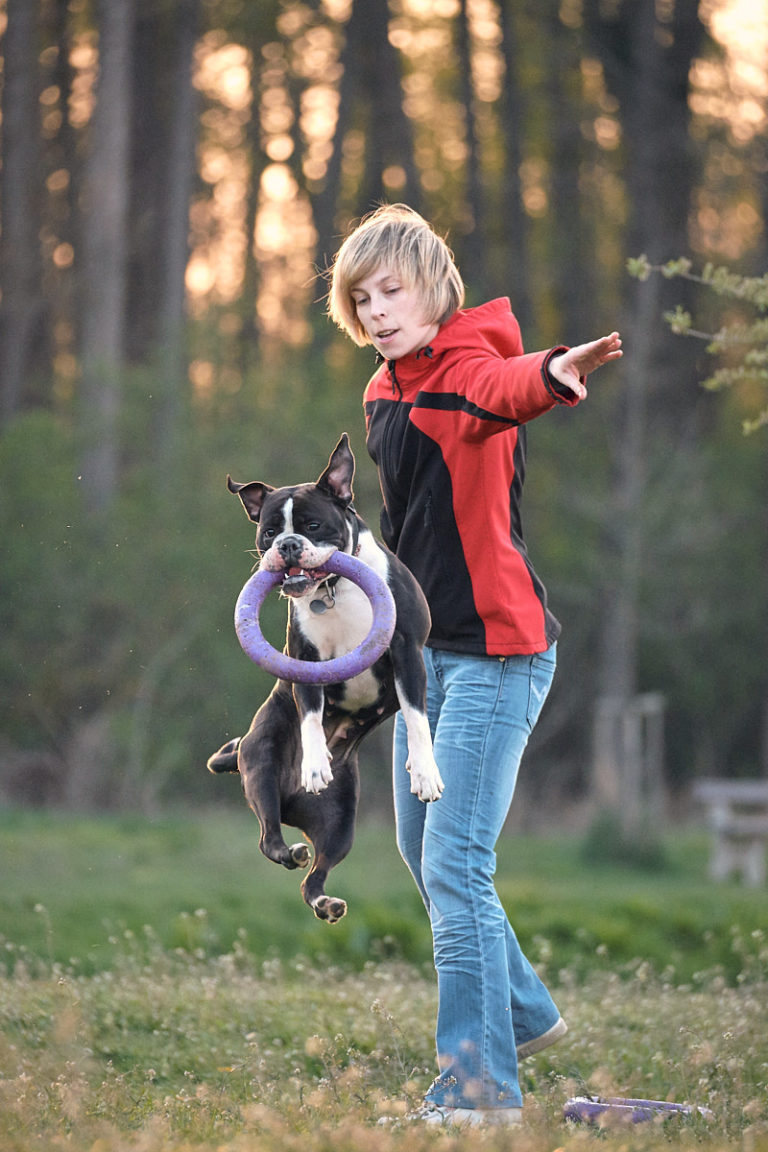Puppy and physical activity
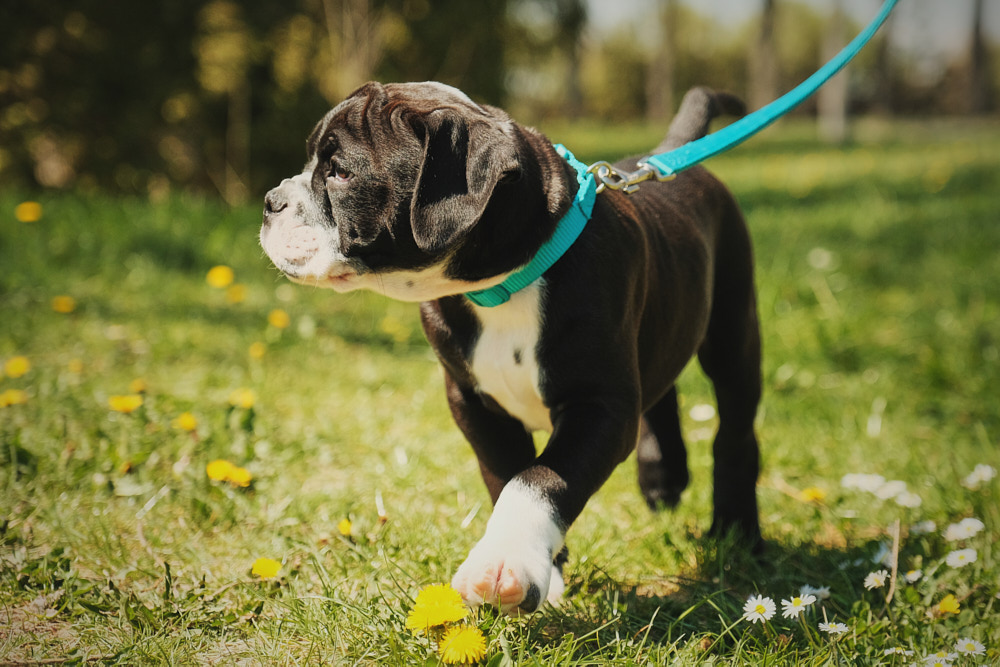
„It´s necessary not to overload a puppy“ we may often hear. But what does it actually mean? How much physical activity is fine and how much is too much?
In this article we present our principles for the ideal amount of physical activity for puppies and young growing dogs. It also lists the main risks of overloading them.
We hope that the article may help someone determine a healthy level of physical activity for their puppy.

continental bulldog puppies?
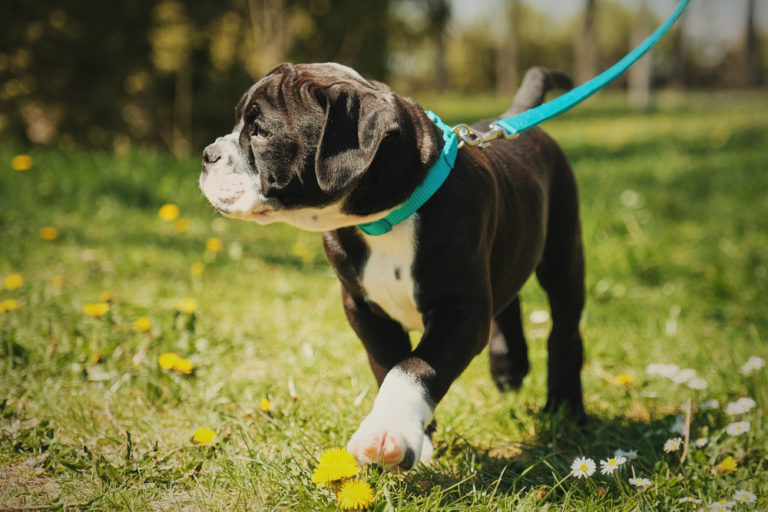
We often read information such as “physical activity needs to be adapted to a puppy” or “it is important not to physically overload a puppy”, but what does this actually mean in practice? How much physical activity is fine and how much is too much? As with humans, all dogs are different, and therefore there are no exact tables for an ideal level of physical activity. Nevertheless, in this short article we will try to state simply and clearly the amount of movement for puppies that we consider appropriate. And also what we already consider to be overloading.
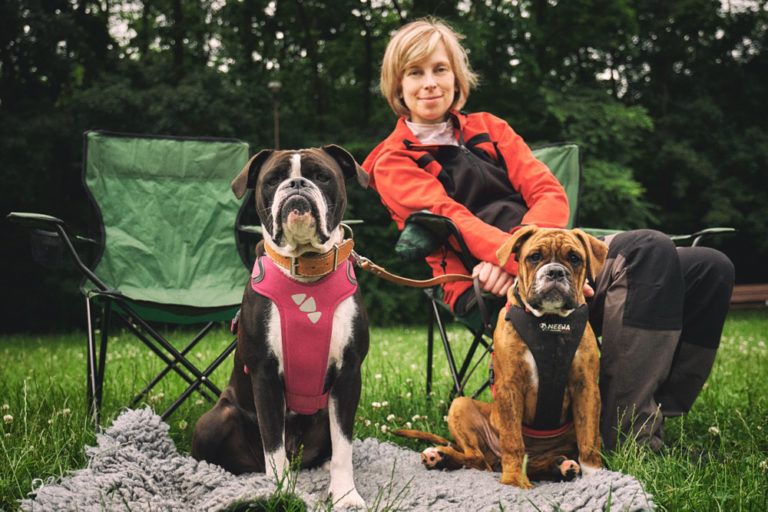
How is a puppy different from an adult dog?
Continental Bulldog is a molossoid breed, i.e. a dog with a heavier body structure and a strong skeleton. Therefore, it is appropriate to pay great attention to the physical activity in puppy age. The period of changing teeth and the greatest growth, roughly between 3 – 10 months of age, is the most critical for a puppy in terms of proper nutrition (more info: Dog nutrition – how to feed a Continental Bulldog?), but also in terms of the appropriate type and amount of physical activity. A familiy takes over their new family member from a breeder usually at the age of about 2 months, when it is still a tiny cute teddy bear, but which will soon grow to its final height by the age of about 10 months.
Dog’s physical growth is very rapid. If we look at a puppy that is 9 months old, we can see a long-legged long-eared creature. Even at the age of one year, a puppy´s movement is not as firm and steady as the movement of an adult dog is. Why is it?
A puppy will first grow to height and length, only then will it slowly begin to thicken. The age of 18 months can be considered physical adulthood. However, a Continental Bulldog will not reach the final adult body structure until about 3 years old. And because at puppy age everything first “stretches ” (total height, length of limbs, length of snout and length of ears) and only later strengthens and thickens, it results in excessive load on all joints and ligaments during movement of a puppy. The musculature, which in adult age easily holds all the joints firmly together and effectively prevents overload, is not so strong and firm yet in the case of puppies and growing dogs. Therefore, the risk of injuries associated with the musculoskeletal system is much higher than with adult dogs. Physically, a puppy is far from being able to handle what an adult dog is. But puppies and teenage dogs are convinced of the opposite…
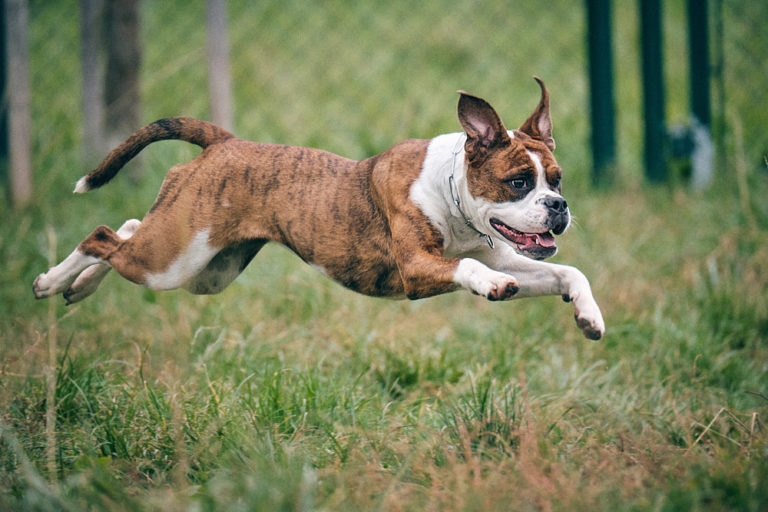
Risks of overload
When a family brings home the cute, cheerful, but also frightened little one, in most cases they don´t undertake any devilishly demanding events or hiking in the mountains. But as the puppy grows, it dares to load more and more, looks less and less like that cute puppy and more and more like an adult dog. And the family often forget that they still have a puppy at home and start behaving as if they had an adult dog at home. They go on longer and longer trips, let the puppy fool around for hours with other dogs, and often start doing sports with the puppy. “The dog is fine, it´s having fun, doesn´t limp at all and loves to be active. So what’s the problem? ”As stated at the beginning of the article, every dog is different, so it doesn’t have to be a problem. But it can be.
Probably the most common injury caused by excessive physical activity of Continental Bulldog puppies is broken knee ligaments. This injury is insidious for several reasons. There is no way to see this injury coming in advance, we notice it suddenly as the puppy has difficulties to stand up or starts limping. Another reason is that once this injury occurs, it can´t be resolved by giving the puppy a rest, this injury can´t be revoked. Conservative treatment is often ineffective so a surgical treatment is necessary, with long convalescence. The price of the treatment, which can exceed the purchase price of the puppy, is certainly unpleasant for the owners. And it is important to mention the fact that during the period of convalescence the dog puts more strain on the healthy leg, therefore the knee ligaments of the healthy leg often break too.
The second common risk of puppies´ excessive physical activity is a worsened degree of dysplasia of hip joints (or even elbows). The joints and ligaments are not yet completely mature, moreover they do not have as much support in musculature as in adult dogs. The result of high stress can be excessive wear of the joints, worsening of the degree of dysplasia, in addition there´s the associated increased risk of developing painful osteoarthritis or its development at an earlier age than usual.
Of course, there are many more movement difficulties caused by excessive load of physical activity, whether it is injured tendons, inflammation of the musculoskeletal system and more. It´s certainly not worth it to downplay any of the risks, whether because of the belief in “it most probably won’t happen to us, we don’t do any terrible physical activities and sport is healthy for any dog”, or even if we know a few other Continental Bulldog owners who “went for long hikes and let the puppy fool around with other dogs for hours and hours, now the dog is three years old and is completely fine “. Also, we must not forget that owners often have no need or reason to debate their dog’s health problems in public.
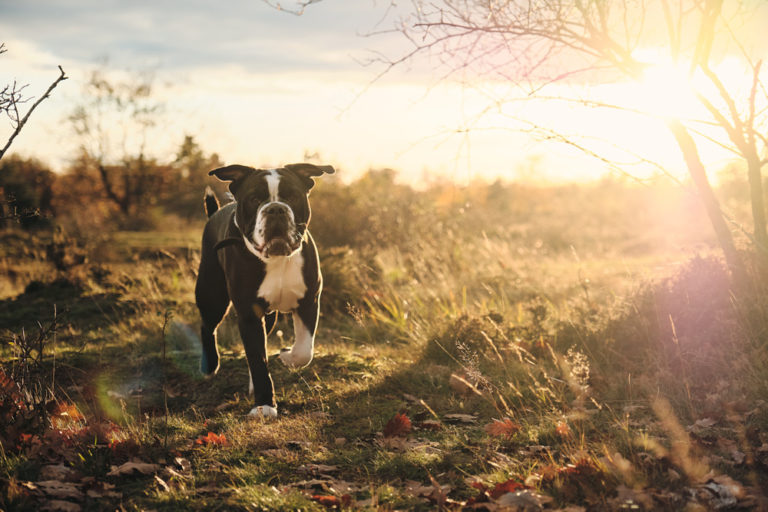
How not to overload a puppy?
And we´re getting to the most important part. What is an apropriate injury prevention? And how much movement is fine for a puppy so that we don’t overload them? We discuss this topic in great detail and carefully with families who are interested in a puppy from our kennel. In this article, we will try to be as concise as possible for clarity, although it is not entirely possible. It is true that each puppy is individual, but in our breeding we generally strive to observe the following rules.
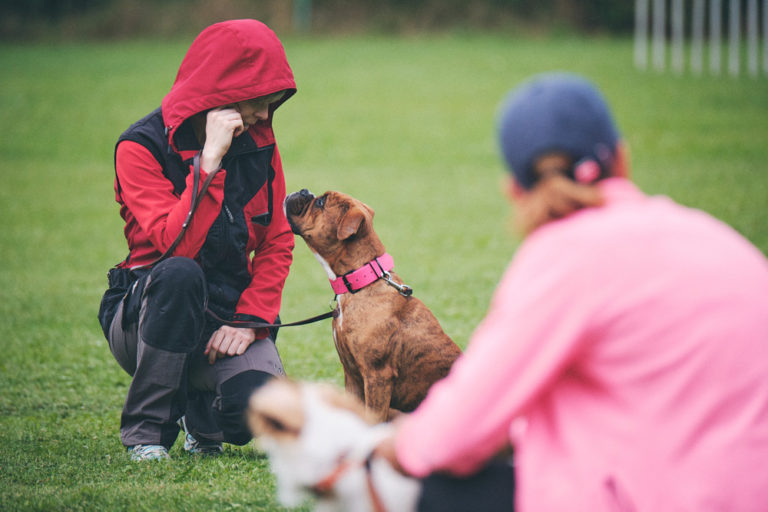
The ideal amount of physical activity
At the age of two months, the appropriate walking time on a leash is practically zero. We don’t do any real walks with a puppy, we just let a puppy get used to the collar and leash outdoors, sniff and socialize with new environments. We may spend more time with a puppy in one place to let them explore it. But we don´t drag a puppy anywhere, we don´t do walks yet. On the other hand, we make sure that we take a puppy to various new places to get used to all kinds of traffic, presence of other people and animals.
Each month we add a few minutes of classic walks on a leash. But really only a few minutes a month, there is no need to hurry. The adequate length of a regular walk at 12 months of age is about 1.5 km, certainly not more.
At the age of 18 months, i.e. before a puppy becomes an adult dog, the length of a regular walk does not exceed 3 km. It is still valid that less is more.
In the case of walks where a puppy can run freely without a leash, we follow the time of the walk, not kilometers. A freely running puppy makes far more kilometers than we do. In this case, again, at 2 months of age we only do socializing „walks“, no proper walks take place yet. We add literally just a few minutes each month, so that at 12 months of age, the length of a regular walk is about 20 minutes. Up to 18 months of age, we should not exceed 40 minutes of a regular walk without a leash. However, this does not mean that we should not take a puppy to new places, puppies needs to have as many new stimuli and perceptions as possible, they needs to socialize with other people and animals and get to know new environments.
Playing with other dogs (or other animals) is suitable and necessary for a puppy´s socialization and healthy mental development. From the point of view of the load on the musculoskeletal system, this is a “necessary evil”. We interrupt such play often to provide a puppy with enough rest. In the beginning, we only let a puppy play with animal friends for 5 minutes or so, then a rest follows, we let a puppy drink and calm down. After a while we can repeat the play. At the age of 2 months, these are really only short socialization plays, because frantic movement during dog play is very demanding on the musculoskeletal system. At the age of 12 months, occasional games with dog friends should not exceed 20 minutes per day, and at the age of 18 months, 30 minutes per day. Of course, we don’t let a puppy wildly play with dog friends every day. In addition, there is no further walk or other physical activity during these play days.
If we go to a dog trainer with a puppy, if we practice obedience etc., then these activities usually last a longer time, e.g. an hour. So again, we make sure that no more physical activity takes place on these training days.
If we feel that we went overboard with a puppy’s physical activity one day, we don´t do any physical activities the next day (or even more days) and let the puppy rest.
Movement in our own garden where it is familiar is very suitable for a puppy. There are not any new sensations that would make a puppy go crazy and run. A puppy usually only occasionally runs, mostly just walks, nibbles at grass, chews sticks, rests, occasionally goes to drink water, or just lies on a sunny place and looks around. This very gentle movement on a healthy surface (grass) is ideal and when the weather is good, a puppy can spend hours and hours a day this way without worries.
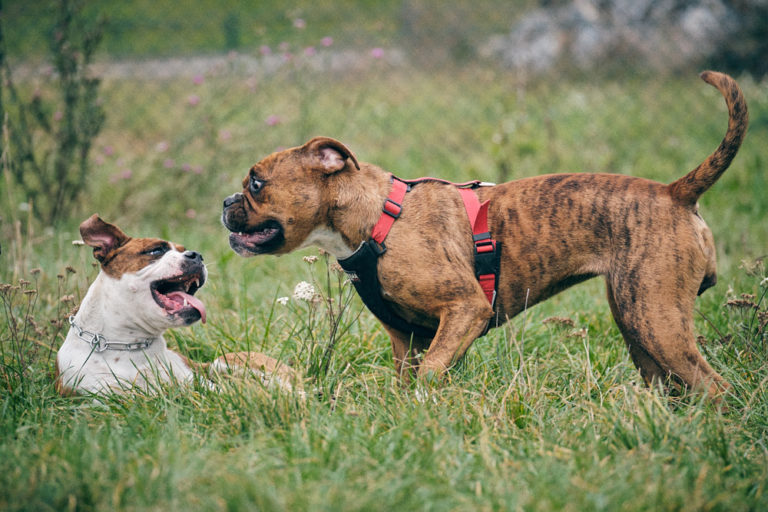
Optimal physical condition
The basic prevention of injuries is the optimal physical condition of a puppy. Even for adult dogs it is advisable to be slim. It is even more important for puppies not to be overweight. With every extra kilogram of weight, the musculoskeletal system is significantly more stressed and the risk of injury increases greatly.
We do not use the “rule of thumb“ to evaluate a puppy´s physical condition, because everyone has a different thumb. A quite reliable method is to examine a standing dog´s chest by touch from the side. If the ribs are clearly tangible even with a slight touch, the puppy is not overweight. When we have to put more pressure to feel the ribs, or when it is even a problem to feel the ribs at all, then it is necessary for the dog to lose weight.
It is very risky to be overweight, but it is not the goal to have an undernourished puppy either. Therefore we do want a puppy to look as emaciated as possible. The goal is to have a puppy in an ideal physical condition, i.e. healthy slim. So if we can see a few ribs when a puppy is moving in the sun, that’s perfectly fine. But if we can see all the ribs very clearly even if, for example, a puppy is huddled in a dog bed in the shade, then the puppy is probably undernourished and should gain a bit of weight.
As already mentioned, Continental Bulldogs reach their final adult body constitution at about 3 years of age. And the time will come. Therefore, we do not try to fatten a puppy or a young dog to „look like proper bulldogs” as soon as possible. It is a common mistake, many owners (often unknowingly) make this mistake. However, it is not beneficial for dogs and also it increases the risk of injury of the musculoskeletal system, so we consciously do our best not to make this mistake.
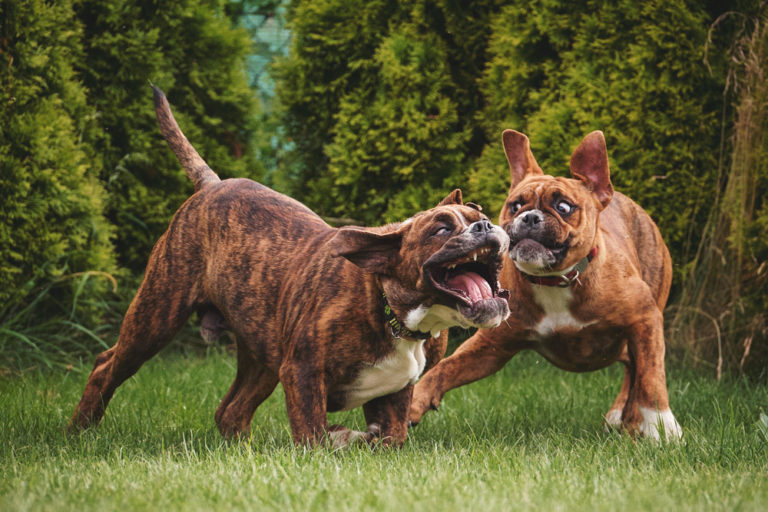
Other principles of prevention
It is necessary to think about a suitable surface on which a puppy moves. Extremely unsuitable are smooth surfaces such as tiles, hardwood flooring etc. Not only are slippery surfaces often associated with a worsening of the degree of joint dysplasia, but they are also very risky in terms of injuries. It is not so problematic when a puppy sometimes walks calmly on a slippery surface, but there should definitely not take place any play with other dogs on it, no running around on it, etc. In adulthood, this is no longer a big problem, but it is necessary to adjust the floor so that a puppy does not slip. The solution may be, for example, a piece of carpet, etc. If we already have slippery surfaces at home, then we do everything to move any plays and physical activities outside to the grass, for example, which is an ideal surface for puppies´ movement.
When playing with dog friends, we make sure that a puppy has suitable terrain to run. Any rugged terrain and places full of stones, roots, we definitely omit. The risk of injury in the case of a jump with a bad landing is extremely high.
We can also help the musculoskeletal system with suitable nutritional supplements. We add quality nutrition for joints and tendons to a puppy’s feed ration.
Every dog is different, every “dog family” have their own lifestyle and different habits. When bringing a new family member home, however, it is necessary to initially adapt to them and do our best for their healthy development and future well-being. After all, Continental Bulldogs normally live to a fairly old age, so there is no hurry. As soon as our dog reaches adulthood, it is possible to start increasing the physical condition and add excercises and sports activities according to our dog´s taste, endurance and actual health condition. The first 18 months of our puppy’s life will pass before we even notice it, and if we don’t make unnecessary mistakes, there is a good chance that the next many years will be cheerful and relaxed. In the end, that is why we choose Continental Bulldogs, isn´t it – to live comfortably with them, to experience the common joy of everyday life, but also to let them cheer us up with their pigheadedness and craziness. And for all of that, we need them to be vital and healthy.
